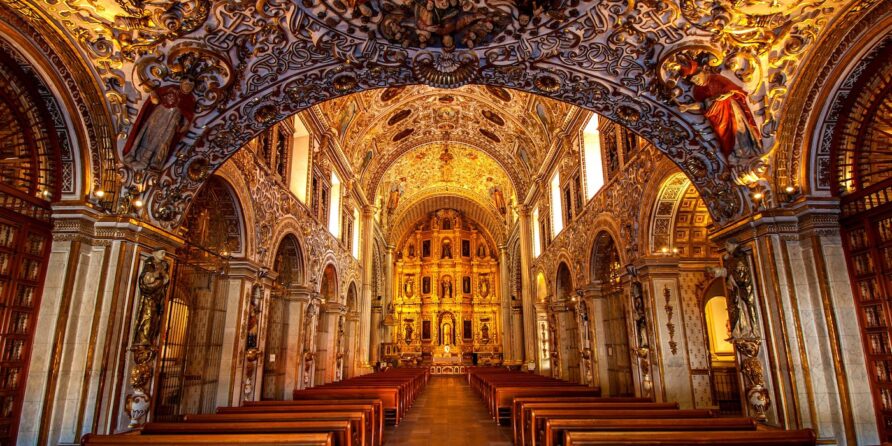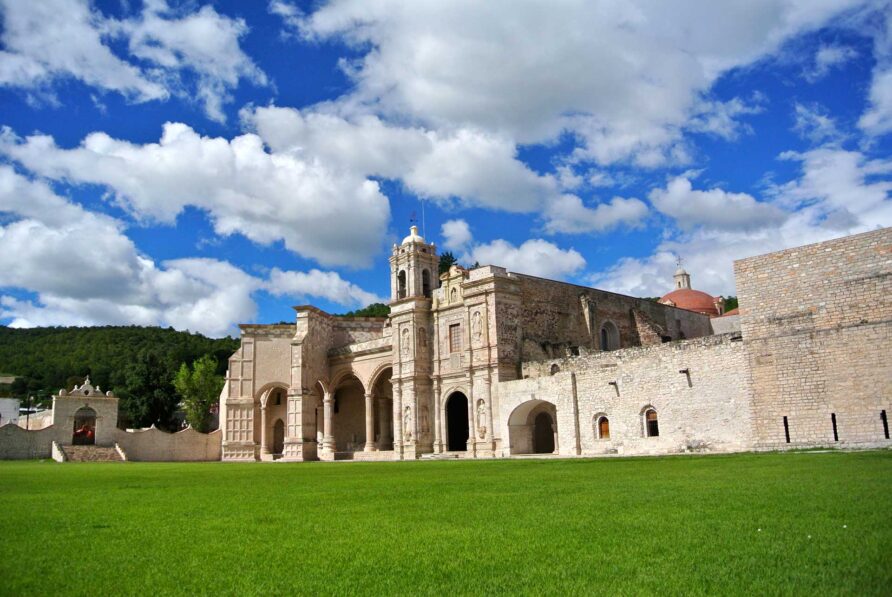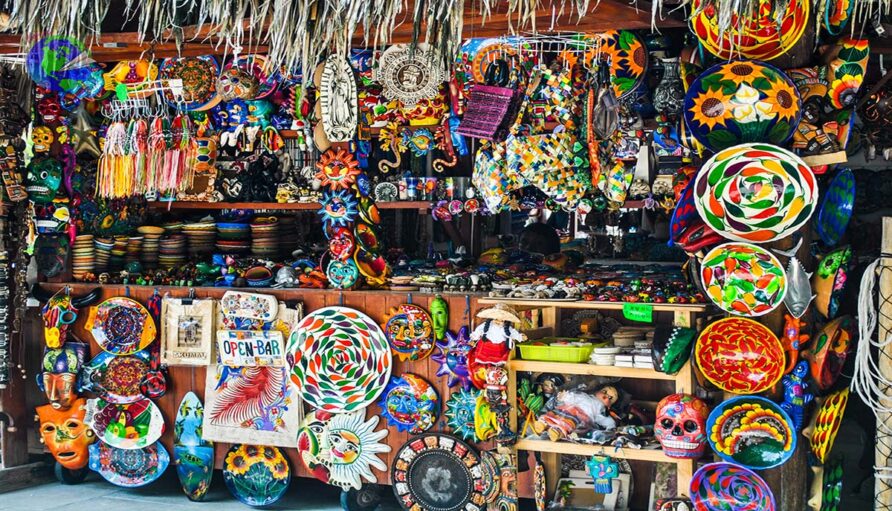Ro-House » Oaxaca »La Guelaguetza

The Guelaguetza It is an ancient tradition with pre-Hispanic roots related to agricultural ceremonies of gratitude to the gods for the arrival of the rains and the lifting of the harvest at the end of July and is the largest festival in Oaxaca. La Guelaguetza is a celebration of gratitude for the arrival of the rains and the harvests, in which representatives from all regions of the state gather in the capital to share their culture through dances, crafts and food.
La Guelaguetza is celebrated every year on the two Mondays after July 16, except when the first Monday is July 18, Benito Juárez's death anniversary.
Many types of dances also participate, such as the traditional Flor de Piña; where women usually dress in Huipiles representing the different regions of the state, as well as with their pineapple on their shoulders, they comb their hair with beautiful long braids accompanied by their ribbons and can not missing her accessories that is, bracelets, necklaces and earrings of precious colors and her beautiful makeup.
The origins
Apparently, this festival has its origin in colonial times and is related to the so-called Corpus Christi festival of the Carmen Alto Church, a temple that the Carmelites built on the slopes of a hill that the Zapotecs had called Bella Vista, and it was celebrated on the Sunday following July 16 and was repeated eight days later in the so-called "eighth."
Festivities in Honor of La Virgen del Carmen Alto
The Corpus Christi festivals faithfully followed the Spanish tradition and were celebrated as part of the ritual of the Catholic temples in the city, then called Antequera. The coincidence between both festivals, the indigenous and the Spanish, facilitated the syncretism that gave rise to the Cerro Mondays festivities, in which the Oaxacan tradition is still preserved with great enthusiasm, which, moreover, is clearly related with the popular belief that Mondays are auspicious days for festive rites.

The Festivities of «Los Mondays del Cerro»

The Hill Monday Festivities take place throughout the month of July with folkloric presentations, concerts, exhibitions, cultural and sports events, standing out:
• La Guelaguetza (Guelaguetza Auditorium)
• The Parade of Delegations
• The Legend of Princess Donají
• The Mezcal and Gastronomic Fair
• As well as many other events and activities within the City and its surroundings.
Guelaguetza is a Zapotec word that denotes the act of participating in cooperation; It is a free gift that carries with it no obligation other than that of reciprocity. The Guelaguetza of the Monday of the Hill is expressed in the offering to the City of Oaxaca that representative groups of the eight traditional regions make:
The Central Valleys, La Sierra Juárez (North), La Cañada, Papaloapan, La Mixteca, La Costa, La Sierra Sur and the Isthmus of Tehuantepec. Each delegation presents a sample of its cultural heritage through dances that they perform to the sound of music and songs that are their own, wearing the gala clothing of their respective towns. At the end, each group distributes its "Guelaguetza" to the public, made up of objects characteristic of their respective regions.
Parades of the Delegations

Recently, other folkloric shows for popular recreation have been added to these festivals, such as the parade of the delegations organized in the manner of the traditional Calenda and which takes place on the Saturday before the first Monday.
This calenda is headed by the "marmota", which is a large spherical lantern covered with cloth, the "giants", the "Chinese oaxaqueñas", women of the city carrying baskets of flowers accompanied by their band and the rockets; They are followed by the other delegations, each one preceded by the music of their region.

The Goddess Centéotl

As part of the Cerro Mondays festivities, the Secretariat of Cultures and Arts of Oaxaca (Seculta), and the Organizing Committee of these celebrations invite Oaxacan women from the eight regions of the entity, to participate in the Contest to choose to the representative of the Goddess Centéotl.
Presentation of the legend of Princess Donají
The General Coordination of Muncipal Tourism presents this show, which has become one of the strongest and indelible traditions of Oaxacans within the Cerro Mondays festivities. The Folkloric Ballet of Oaxaca stages this legend in this great show of music, light and dance. It takes place on Sunday afternoon, before the presentation of the Guelaguetza on "Monday of the Hill."
Presentation at the «Guelaguetza Auditorium»

On Monday at five in the morning, the "chirimeteros" of the Central Valleys play the "mañanitas" on the hill, with whistles, drums and shawms, while people begin to arrive at Cerro del Fortin, where the Auditorium is located. Guelaguetza, where you can enjoy a succulent Oaxacan lunch, before entering the auditorium where the marimba and the chirimeteros offer an audition to the audience. At ten in the morning the Guelaguetza begins.
The Mezcal Fair
Gallery, gastronomic exhibition, cultural and artistic forum in an area of eight thousand 900 square meters in the shape of a cross is the extension that the Oaxaca National Mezcal Fair occupies in the Parque Paseo Juárez "El Llano".

More Tourist Attractions in Oaxaca
The name mezcal has its roots in one of the ancient native languages of the area and translates as 'agave (also known as maguey) cooked'. Although pre-Hispanic Oaxaqueños used maguey to make pulque (an undistilled alcoholic beverage), it seems that the real advances in mezcal production occurred when the Spanish arrived in Oaxaca; by bringing with them their knowledge of distillation processes.
The beaches of the coast of the state of Oaxaca are among the most beautiful and complete in Mexico, thanks to a developing tourist infrastructure and the rich gastronomy of the Pacific. Along the 533 kilometers of coastline, the beaches of Oaxaca offer a wide variety of activities for lovers of water sports: snorkeling, diving, sport fishing, surfing, among others ... there is something for everyone!
Places such as Puerto Escondido, Mazunte, Zipolite, Carrizalillo, Puerto Ángel or the beaches of Huatulco will offer you the possibility of contemplating beautiful sunsets, delighting in intense adventure tourism or witnessing the exciting release of newborn turtles.
The vast Oaxacan cuisine is distinguished by its tradition and the use of regional ingredients. Not for nothing has it positioned itself as the Best Tourist City in the World and the Best Gourmet Destination. In the presentation of the 2021 edition of The Mexico Gastronomic Guide "The Great Restaurants of Mexico" 278 restaurants located throughout the Mexican Republic were recognized, on this occasion, there were 16 Oaxacan restaurants that were placed in the list .
The City of Oaxaca is a destination that offers a great variety of tourist attractions and charms that leave anyone surprised. However, there are other places that are also worth knowing and are in the surroundings of the city, in whose surroundings various populations are located, each with its own personality and artisan tradition, accompanied by their respective customs, festivals and dishes. .
Oaxaca is famous throughout the world for its archaeological sites and the history they keep. Discover Monte Alban, Mitla, Yagul and more of these remote sites, which have made Oaxaca a World Heritage city, according to Unesco. The original Zapotec and Mixtec peoples of Oaxaca lived in the cities and religious centers of the valley of this city until the time of Spanish colonization. Today, there are still vestiges of these towns and places where you can meet them.
Monte Albán is the most important archaeological zone of the Oaxacan entity, of unique regional importance due to the religious, political and economic control that the Zapotec state exercised over the population of the Valley of Oaxaca for more than thirteen centuries. It has been named by UNESCO as Cultural Heritage of Humanity along with the city of Oaxaca on December 11, 1987. The heritage of the Zapotec world reaches us through the magnificent archaeological sites designed in the Valley of Oaxaca. Of these, the city of Monte Albán stands out for its enormous importance as an economic, political and religious hub (it was the first urban complex in Mesoamerica); by its extension, almost as big as the current capital of Oaxaca; and for its long life, started around 500 BC and concluded around 850 AD
Oaxaca City, the state capital, is famous for its architecture and rich cultural traditions. Oaxaca also has a splendid and varied cuisine and a spring climate throughout the year. UNESCO declared the city a Cultural Heritage of Humanity. Oaxaca is the most diverse state in Mexico. It has peaks that reach more than 3,000 meters in height, caverns that are among the deepest in the world, pristine beaches, secluded forests and sunny valleys. Oaxaca is rich in traditions and customs and has the largest ethnic population in Mexico.
The Santo Domingo Cultural Center is a cultural complex that is located in what was one of the most important convents in the colony. It is a large convent in which the Museum of the Cultures of Oaxaca, the Fray Francisco de Burgoa Library and the Ethnobotanical Garden have been established. The Néstor Sánchez Public Newspaper Library is located in a building that is part of the complex but dates from the 19th century. Apart from all these institutions brought together, the Santo Domingo Cultural Center has multipurpose spaces in the former convent, in which temporary exhibitions, conferences, courses, book presentations and concerts are held, among many other activities.
In Oaxaca we are proud to have 5 communities that have been awarded the title of Magic Towns of Mexico, a Magic Town is a town that has symbolic attributes, legends, history, transcendent events, everyday life, in short magic that they emanate in each of their socio-cultural manifestations, and that today mean a great opportunity for tourist use. The Magical Towns Program contributes to revalue a group of populations in the country that have always been in the collective imagination of the nation as a whole and that represent fresh and different alternatives for national and foreign visitors.
Crafts in Oaxaca are so varied and of such good quality that they have become a tourist attraction. The ancestral traditions, the diversity in the ethnic groups, as well as the richness in the history of the state have been manifested in the great diversity of creations of more than half a million artisans that are registered in Oaxaca. In the center of the state is the City of Oaxaca, a fascinating and hospitable capital in whose surroundings various towns are located, each with its own personality and craft tradition, accompanied by their respective customs, festivals and dishes.
In the state of Oaxaca there are many customs and traditions throughout the year, and within the state, said that they have the same purpose of celebration but with different things, in fact from one region to another or even more from one town to another, the Customs vary for perhaps details but that is what makes them authentic. Oaxaca has deep-rooted customs and traditions. All the holidays are celebrated, the profane and the religious ones. The festival calendar is extensive due to the diversity of ethnic groups, which they still conserve.
Oaxaca's culinary tradition is extraordinary and deeply rooted. There are fourteen different ethnic groups, with their own dishes. It is an area of incomparable wealth for the tourist interested in gastronomy, ethnology and culture in general. Oaxaca is the land of mezcal, tlayudas and the famous seven moles. You have to dedicate several days to it. Oaxacan gastronomy is one of the cultural manifestations that identify and define its people, due to its variety, richness and complexity that have been preserved through the centuries. The best way to enjoy Oaxacan food is by tasting it, from the “strong” dishes that are used to enjoying at lunchtime; like the traditional Oaxacan snacks that can be enjoyed at any time of the day.
An ideal space for Alternative Tourism, Oaxaca offers activities such as walking, mountain biking, rappelling, climbing, zip-lining, horseback riding, observation of flora and fauna and more, in close contact with nature. The visitor can also witness the various aspects of local life, savor the gastronomy and enjoy the warmth of its people, as well as an offer of accommodation in hotels, ecotourism cabins, local houses or excellent camping areas. In its varied geography, it brings together not only a vast biodiversity, considered among the largest in the world, but also insurmountable cultural and ethnic riches, and the most different and beautiful natural settings.

Guided Tours in Oaxaca




















